About 53% of app users expect an app will start in 1 second, and 80% of them are not ready to continue using a software with freezes and crashes.
Developing faster apps is no longer a luxury, but a necessity for businesses and developers who want to embrace the future of software technology. To cover that necessity, it’s possible to hire a dedicated full-stack developer who can:
- Enhance an interaction between frontend and backend components by enabling seamless integration of modules, APIs, and databases;
- Keep an eye on an app’s performance in the long run.
Sit back, as we are to provide more details on why and how to speed up an app.
The Cost of Slow Apps Vs. The Cost of an App Optimization

Companies like Netflix and Amazon have already demonstrated the speed relevant to the future of software development. Netflix’s focus on speed and efficiency has enabled it to reduce its page load time by 70%, resulting in a significant increase in user engagement and revenue. Similarly, Amazon’s obsession with speed has led to the development of its one-click ordering feature, which has revolutionized the online shopping experience.
While app optimization requires an upfront investment, it pays dividends in the long run:
- Increased revenue. Mobile users who experience fast rendering times bring 75% more revenue than average and 327% more revenue than those who experience slow render times. Plus, 50% of users are willing to pay more for an app that outperforms competitors.
- Protected brand reputation from damage. 63% of users actively discourage others from using a service with a bad digital experience. At the same time, apps with excellent UX delight users and become highly recommended.
- Saved costs. Investing in speed optimization upfront reduces the cost of further retesting and rework.
Strategies for Developing Faster Apps
By sticking to these 4 proven strategies, developers can build faster apps and shape the customer-oriented future of software engineering.
1. Optimize Code
The first step towards building faster apps is identifying and eliminating bottlenecks in the code. Code optimizing not only makes apps faster, but also allows developers to ship reliable code quickly, reducing time-to-market.
Here are some tips we can provide without checking your code.
- Mobile native frameworks like Java/Kotlin for Android and Swift/Objective-C for iOS generally offer better performance than cross-platform frameworks.
- For cross-platform apps, use tools and frameworks that can deliver native-like performance.
- Newer edge computing technologies can help process data nearer to the user.
- Algorithms with low time and space complexity reduce processing time and memory usage.
- Data structures like arrays, lists, and hash tables help with storing and accessing data efficiently.
- Caching, lazy loading, and asynchronous operations typically optimize an app’s performance.
- To reduce the frequency and size of network requests and data transfer, combine multiple requests, use efficient protocols, compress data, store frequently accessed data locally, employ data pagination, optimize images, enable offline access, and use background sync for updates.
Yet, with a dedicated developer on your team, you can get more tailored solutions.
2. Invest into Stellar UI Design

- The most minimalistic yet functional competitors’ apps;
- Behavior and expectations of potential users.
3. Leverage AI and ML
AI and ML can improve app performance in several ways.
- Make an app’s interface more intuitive and user-friendly by dynamically adjusting it to a user’s preferences.
- Optimize resource allocation (like CPU or memory) in real-time.
- Predict and address potential issues.
- Offer more scenarios for A/B testing.
- Uncover insights about user satisfaction based on tracking user behavior and reviews.
- Launch automatic testing and suggest necessary code optimizations.
Can you agree that the future of software engineering is hard to imagine without further improvements of Artificial intelligence (AI) and machine learning (ML)?
4. Opt for Cloud Services in App Development

Auto-Scaling of the computing resources. This ensures that the app always has the necessary resources to handle varying loads, preventing performance bottlenecks during peak times.
Global Distribution. Cloud providers have data centers across the globe. Deploying the application closer to end-users reduces latency and improves response times.
Automatic Load Balancers that distribute incoming traffic across multiple servers to ensure that no single server is overwhelmed.
Replicating data across multiple locations and failover mechanisms to ensure that the application remains available and performs well even in the event of hardware failures.
In-Memory Caching. Services like Redis and Memcached, offered by cloud providers, allow for efficient in-memory caching, which speeds up data retrieval times and reduces load on databases.
Distributed Caching. Cloud-based distributed caches store frequently accessed data closer to the application, reducing latency and improving performance.
Managed Databases. Cloud providers offer optimized, managed database services that are fine-tuned for performance.
Database Scaling. Databases can be scaled vertically (more powerful instances) or horizontally (adding more instances) based on the workload, ensuring they can handle high transaction volumes efficiently.
Real-Time Monitoring. Cloud platforms provide comprehensive monitoring and logging services, enabling real-time performance tracking.
Application Performance Management (APM). Tools like AWS X-Ray, Azure Monitor, and Google Cloud Operations Suite provide deep insights into application performance, helping to optimize and troubleshoot performance bottlenecks.
Instance Types. Cloud providers offer a wide range of instance types (e.g., CPU-optimized, memory-optimized, GPU-accelerated) that can be tailored to the specific performance needs of the application.
Containers and Kubernetes. Container orchestration platforms like Kubernetes manage containers efficiently, ensuring optimal resource utilization and consistent application performance.
Optimized Network Infrastructure. Cloud providers have optimized network infrastructures with high-speed connectivity and low-latency connections, which enhance the performance of distributed applications.
Virtual Private Clouds (VPCs). VPCs offer isolated network environments with customizable network configurations, improving security and performance.
Is Your Team Ready for The Future of Software Development?
The future of software development is all about speed, agility, and efficiency. With the rise of cloud computing, artificial intelligence, and machine learning, developers have a bunch of tools and technologies to build faster and more efficient apps. But, wait… This also means that the competition is fiercer than ever, and developers must keep their skills as sharp as never before.
In this light, well-performed tech talent acquisition becomes one of the strategies of speeding up software products. Spot team players who can keep their focuses on the commercial result of your project, looking for new speed optimization solutions when the old ones no longer work.

